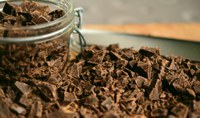Prairie Fare: Does Chocolate Have Health Benefits?
(Click an image below to view a high-resolution image that can be downloaded)
By Julie Garden-Robinson, Food and Nutrition Specialist
NDSU Extension
I recently returned from “the sweetest place on earth.”
Do you know where that is? I’ll give you a hint. After registering at the lodge, you receive a chocolate bar in a maroonish-brown wrapper.
I was in Hershey, Pa., at a nutrition conference. After our treat at check-in, we were enticed with chocolate on our pillows, nightstands, meeting tables and dessert tables.
The shampoo, conditioner, lotion and soap were chocolate scented. The wallpaper featured chocolate kisses, and the bedding was embossed with, you guessed it, the famous candy kisses. Even the street lamps were shaped like kisses.
By the week’s end, I had more than my fill of chocolate. However, just like being overstuffed at Thanksgiving, I recovered. A little piece of chocolate sounds inviting again.
We went to a local attraction, and I rode around an educational exhibit in a metal cocoa bean “car” as I learned about processing cocoa beans to make chocolate candy.
Chocolate candy begins with the fruit from the Theobroma cacao tree. Cocoa beans are fermented, dried and roasted, then their shells are removed. Next the “nibs” (pure cocoa beans) are ground to form a paste, and the cocoa is separated from the cocoa butter to form cocoa liquor.
To make powdered cocoa, much of the fat is removed from the cocoa liquor. To make dark chocolate, sugar is added to the chocolate liquor. As you might guess, milk chocolate contains cocoa liquor, sugar and, of course, milk.
Then the chocolate is tempered, where the temperature is raised and lowered in a controlled manner, and finally the chocolate is molded into shapes and wrapped.
White chocolate is made from cocoa butter plus sweeteners and other ingredients.
The candy company began more than 100 years ago with caramels and later, Milton Hershey switched the focus to chocolate.
We weren’t at the conference to learn about chocolate, but I did pick up a few nuggets of wisdom.
The good news: A moderate amount of chocolate has been shown to have some health benefits.
Note the word “moderate.”
Chocolate has a long history dating back to about 460 A.D. It was used as a medicine by early people.
Chocolate is rich in antioxidant compounds with names such as catechin, epicatechin and procyanidins. Antioxidants are the body’s defenders, and they are found in a variety of fruits, vegetables and, yes, cocoa beans and other types of beans. Cocoa also contains several minerals, including copper, magnesium, potassium and iron.
By the way, cocoa doesn’t count as a vegetable even though it is from a bean.
Cocoa compounds have been studied extensively, and researchers have reported several potential benefits for several body systems, including our cardiovascular system, our nervous system and even our skin.
Some researchers have reported that eating some chocolate may reduce our risk for heart attacks, strokes and diabetes. Other researchers have shown positive results of cocoa consumption on mood and brain function.
Chocolate isn’t a magic cure-all, though. Your overall diet, physical activity and other lifestyle factors, and your genetics, play the most important roles in your health.
In some people, consuming chocolate may trigger migraine headaches or gastroesophageal reflux (“heartburn”). Other people are allergic to ingredients in chocolate, such as milk.
Remember that chocolate often is high in fat and sugar, which provide ample calories and could promote weight gain. An extra 100 calories per day theoretically can add 10 pounds to your frame per year. Balance your food with physical activity.
By the way, dark chocolate and milk chocolate have potential health benefits, but dark chocolate is higher in antioxidants. If you prefer milk chocolate, enjoy it and be sure to eat colorful fruits and veggies because they also are high in antioxidants.
Savor each chocolate candy morsel slowly. Smell it and snap a piece from the bar by your ear. Good-quality chocolate has a “snap.” Then let it melt in your mouth and savor the richness and flavor.
While I was at the conference, I stopped at the Partnership for Food Safety Education educational booth (http://www.fightbac.org) and picked up this chocolatey recipe. It has food safety guidance incorporated in the step-by-step directions for these antioxidant-rich cookies.
Yes, this is a treat to be consumed in moderation. I ran the nutrition analysis using my computer software with and without the added chocolate and marshmallow to show the differences that recipe changes can have on nutritional information. I trimmed 70 calories per cookie by leaving off the optional ingredients.
Treat for the Day Hot Chocolate Cookies
1/2 c. unsalted butter
12 ounces semisweet chocolate chips
1/4 c. Dutch processed cocoa powder
1 1/2 c. all-purpose flour
1 1/2 tsp. baking powder
1/4 tsp. salt
1 1/4 c. light brown sugar, packed
3 large eggs, room temperature
2 tsp. pure vanilla extract
Optional: 8 ounces dark chocolate, cut into 1/2-inch squares, plus more grated for garnish
Optional: 12 large marshmallows, cut in half
- Wash hands with soap and water.
- Combine butter and semisweet chocolate chips in a small saucepan over medium-low heat. Stir constantly until chocolate is melted and smooth. Remove from heat and let cool for 10 minutes.
- In a medium mixing bowl, whisk together cocoa powder, flour, baking powder and salt until combined.
- In a large mixing bowl, beat brown sugar, eggs and vanilla on medium speed until smooth. Add cooled melted chocolate and beat until just combined. Add flour mixture in batches, beating on low speed until just combined, stopping to scrape down sides of bowl as needed.
- Don’t eat raw dough or batter.
- Cover and chill dough in refrigerator for one to two hours.
- Wash hands with soap and water.
- Preheat oven to 325 F. Line two baking sheets with parchment paper. Remove dough from refrigerator and scoop into 2-tablespoon-sized mounds onto prepared baking sheet, spacing cookies 2 to 3 inches apart. Flatten cookies slightly. Wash hands after handling raw dough.
- Bake cookies 10 minutes, until tops start to crack.
- Optional: Remove from oven and place a square of dark chocolate onto the center of each cookie. Top the dark chocolate with the marshmallow halves, cut side down, pressing down slightly into cookie. Return to oven for six minutes, until marshmallows soften.
- Remove cookies from oven and let cool on baking sheet for five minutes before transferring to wire rack to cool completely. Top cookies with shaved dark chocolate and serve immediately.
- Store in airtight container for up to one week.
Makes 24 cookies. Without the extra marshmallow and chocolate, each cookie has 190 calories, 8 grams (g) fat, 2 g protein, 1 g fiber and 80 milligrams (mg) sodium. Note: You could dust the cookie tops lightly with powdered sugar in place of the optional ingredients. With the added marshmallow and chocolate, each cookie has 260 calories, 11 g fat, 3 g protein, 39 g carbohydrate, 2 g fiber and 85 mg sodium.
(Julie Garden-Robinson, Ph.D., R.D., L.R.D., is a North Dakota State University Extension food and nutrition specialist and professor in the Department of Health, Nutrition and Exercise Sciences. Follow her on Twitter @jgardenrobinson)
NDSU Agriculture Communication - Oct. 10, 2019
| Source: | Julie Garden-Robinson, 701-231-7187, julie.garden-robinson@ndsu.edu |
|---|---|
| Editor: | Ellen Crawford, 701-231-5391, ellen.crawford@ndsu.edu |



